| Campaniform
sensillum: pore-like sensory organs in cuticular surfaces, for
example on the metanotum and on tergite IX of many Thripidae; these
are mechano-receptors that are homologous with setae, in that each
is innervated by a single nerve. |
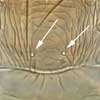 |
| Cilia: slender
hair-like processes around the margins of the forewings, that represent
modified setae; in Terebrantia these cilia arise from sockets that
are 8-shaped, such that each cilium can be moved between stable positions
at either end of the 8; each cilium can thus be folded parallel to
the forewing margins when the wings are not in use. In Tubulifera the
cilia are rigidly attached just below the wing margins, typical socket-forming
cells failing to develop in the pupal stages, and these cilia can thus
not be folded. |
 |
| Clavus: the
lobe at the base of the forewing on its posterior margin. The clavus
usually bears a row of setae on the anterior margin and one discal
seta near the base in Thripidae; at the apex of the clavus is a process
that is involved in linking the forewing to the hind wing. |
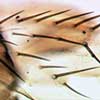 |
| Comb: the
posterior margin of tergite VIII of many Terebrantia bears a series
of closely spaced and slender microtrichia that are presumably used
to comb the cilia of the wings prior to taking flight. The form of
this comb varies between taxa, and a similar comb is present on more
anterior segments in several different groups of Terebrantia. |
 |
| Compound
eyes: the eyes vary in shape between species, and consist of
a variable number of ommatidia that sometimes themselves vary in
diameter. The eyes are usually symmetrical, dorsoventrally, but in
unrelated species of widely differing biology the eyes are much longer
ventrally than dorsally. Conversely, in a few species the eyes are
smaller ventrally than dorsally, and in Macrophthalmothrips, and
a few other Neotropical Phlaeothripinae, the eyes are enlarged, almost
meeting in the mid-line and surrounding the ocellar triangle. In
taxa such as Stephanothrips the eyes are reduced to less than eight
ommatidia. |
 |
| Costa:
most anterior longitudinal wing vein, running along the
costal margin of the wing and ending near the apex. |
 |
| Costal
cilia: the cilia along the anterior (costal) margin of the forewing
in Terebrantia. |
| Cross
veins: short veins in the forewing of Terebrantia, joining the
longitudinal wing veins. Thripidae have one cross vein, joining the
two longitudinal veins near the base. Melanthripidae and Aeolothripidae
have several cross veins between all three longitudinal veins. |
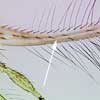 |
| Ctenidia: oblique
comb-like structures of very short microtrichia on the lateral discal
area of tergites VI and VII in species of Thrips and Frankliniella.
The exact position of these ctenidia relative to the tergal setae,
and also to the spiracles on tergite VIII, varies consistently between
genera. |
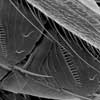 |
Discal
seta: Abdominal sternites of Thysanoptera bear a series of setae
at the posterior margin, commonly three pairs. Many species also
bear setae on the disc of several sternites, usually in one or more
irregular transverse rows, but reduced in a few species to a single
pair placed laterally.
|
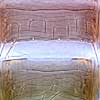 |
| Endofurca: the
internal skeleton of the meso- and metathorax, the second and third
segments of the thorax; the two furcae develop as independent invaginations
from the ventral surface of their segment, and provide important muscle
insertion points. In most species the furca takes the form of a pair
of short arms protruding laterally. In some species the metafurcal
arms are elongate and extend forward, whereas in others there is a
simple straight spinula that extends forwards medially. The mesothoracic
furca commonly bears a median spinula in Thripinae, but this is not
developed in Panchaetothripinae. |
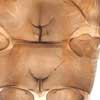 |
| Glandular
areas: areas of cuticle with an iridescent, porous appearance
that are assumed to have some secretory function. These areas are
found primarily on the sternites of male Thripidae, and on sternite
VIII of male Phlaeothripidae - Phlaeothripinae. However, small glandular
areas are sometimes found on the sternites of female Thripidae, and
the dorsal surface of the head of male Merothrips is almost entirely
glandular in structure. |
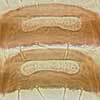 |
| Mandible: only
the left mandible is developed in larvae and adult thrips. This is
used to punch a hole in a leaf surface, through which the maxillary
stylets are then inserted into the cells beneath. |
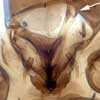 |
| Maxillary
stylets: long slender feeding stylets that are developed from
the laciniae of the maxillae. These are co-adapted with a tongue
and groove system along their margins to form a feeding tube. The
tube is about 3 microns in diameter in most species, but is 5 to
10 microns in diameter in the Phlaeothripidae-Idolothripinae in which
larvae and adults feed by ingesting whole fungal spores. The length
of these stylets varies greatly; in some species they are restricted
to the mouth cone, but in other species they are retracted to the
compound eyes. |
 |
| Mesonotum: the
dorsal surface of the second, middle, segment of the thorax; the arrangement
of the median two pairs of setae provides useful diagnostic features. |
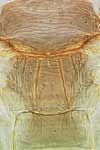 |
| Metanotum: the
dorsal surface of the third, posterior segment of the thorax, usually
comprising two major sclerites. The larger, the metascutum, commonly
bears sculpture and setae whose form and position provide useful species
diagnostic features. The smaller posterior sclerite, the metascutellum,
is not developed in wingless thrips. |
| Microtrichia: minute
setal-like projections of the chitinous surface of the body and wings
(in older lilterature sometimes referred to as microsetae or microsetulae,
but microtrichia do not have an articulated base, nor a nerve supply,
in contrast to setae). |
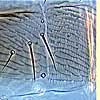 |
| Ocellar
setae: 3 pairs of setae are commonly found on the head in the
region of the ocelli; pair 1 is in front of the fore ocellus; pair
2 arise laterally close to the inner margin of the compound eyes;
pair 3 varies in position between different species but is often
near the anterolateral margins of the ocellar triangle. |
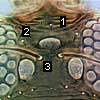 |
Ocellar
triangle: the area on the dorsal surface of the head of adults
delimited by the 3 ocelli. |
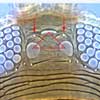 |
| Ocellus: (plural
ocelli) the 3 simple eyes situated in a triangle between the compound
eyes of adults; in some species the fore ocellus overhangs the bases
of the antennae, and is thus slightly further apart from the pair of
hind ocelli than these two are from each other. Ocelli are usually
not developed in wingless adults. |
| Pedicel: the
narrowed base of an antennal segment; in some species of Frankliniella the pedicel and surrounding areas at the base of antennal segment III
is variously expanded. |
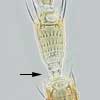 |
| Pleurotergites: a
pair of sclerites laterally on the abdomen, particularly in Thripidae;
each bears a single posteromarginal seta and in some species one or
more discal setae. |
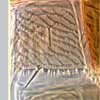 |
| Postocular
setae: in species of Phlaeothripidae there is usually a single
pair of major setae arising just behind the eyes. In Terebrantia
adults a row of usually small setae extends across the head behind
the eyes; it is customary to number these from the midline outwards,
thus "setae B1" refers to the pair nearest the midline
behind the ocelli. |
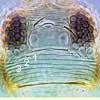 |
| Pronotal
setae: In adult Thripidae the arrangement of pronotal setae is more varied,
the most common condition being the presence of two pairs of posteroangular
setae. |
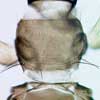 |
| Pronotum: the
dorsal surface of the first, anterior, of the three segments of the
thorax; the posterolateral angles may be delimited by a suture that
separates a pair of sclerites, the epimera. |
| Reticulate
sculpture: the chitinous surface of a thrips rarely completely
lacks some form of structural pattern. This usually takes the form
of faint lines that form a reticulum, either equiangular or frequently
transverse. This faint reticulation is strongly developed in many,
often unrelated, species and in some Panchaetothripinae the margins
of the reticles form raised walls. |
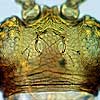 |
| Sensorium: used
particularly in reference to the sensory organs on the antennae. These
sensoria are derived from sensilla placodea, or pore plates, and they
are innervated by several neurones in contrast to setae and campaniform
sensilla. The antennal sensoria of primitive Thysanoptera were probably
simple flat areas, but in the more advanced families, Thripidae and
Phlaeothripidae, they are produced into sense cones that may be simple
or forked. In the intermediate families, the antennal sensoria exhibit
a diversity of forms. |
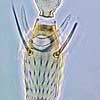 |
| Setae: hair-like
processes with a basal articulation; each seta is innervated by a single
nerve, as are the pore-like mechano-receptors, campaniform sensilla
(in contrast to microtrichia that are rigid projections from the cuticle
surface without any nerve supply). |
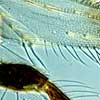 |
| Spinula: median
process in some species on the anterior margin of the endofurca on
the meso- or metathorax. |
 |
| Sternites: ventral
sclerites of the abdomen; these provide various character states that
are useful in distinguishing species, including the number and position
of setae on the posterior margins, the number and position of setae
on the discal areas, and the presence and position of glandular areas
in males and more rarely females. |
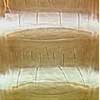 |
| Tergite
X: in female Thripidae, tergite X is conical, divided longitudinally
on the ventral surface, and frequently with a partial or complete
longitudinal split dorsally. In Phlaeothripidae the tenth abdominal
segment is tubular with the anus at the apex and the genital opening
at the base, but the form of this tube varies in shape and length
between species. |
 |
| Wings: adult
thrips usually bear two pairs of wings, but many species are wingless
(apterous), or have the wings very short and functionless (micropterous).
In Tubulifera the four wings lie flat on top of each other on the abdomen
when not in use, their marginal cilia enmeshing with the sigmoid wing-retaining
setae on the tergites. In Terebrantia the two pairs of wings lie more
or less parallel to each other, their marginal cilia enmeshing with
various combinations of setae, microtrichia and ctenidia on the tergites
that vary between taxa. |
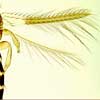 |
| Wing
veins: veins are not visible in the wings of Phlaeothripidae,
although a longitudinal dark mark is often present. Terebrantia have
3 longitudinal veins in the forewings, the costa along the front
margin, and the first and second veins. Members of the Aeolothripidae
and Melanthripidae have several cross veins joining the two longitudinal
veins, whereas Thripidae have only a single cross vein near the base
of the wing. |
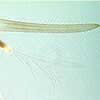 |
